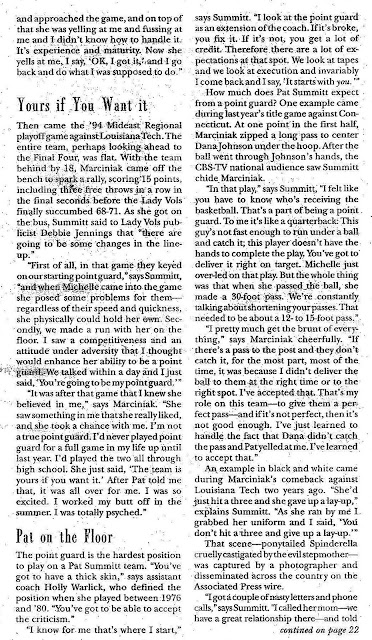Below are the late coach Pat Summitt's “Definite Dozen” rules for achieving success in any endeavor.
Respect Yourself and Others
There is no such thing as self-respect without respect for others.
Individual success is a myth. No one succeeds all by themselves.
People who do not respect those around them will not make good team members and
probably lack self-esteem themselves.
When you ask yourself, “Do I deserve to succeed?”, make sure the answer is yes.
Individual success is a myth. No one succeeds all by themselves.
People who do not respect those around them will not make good team members and
probably lack self-esteem themselves.
When you ask yourself, “Do I deserve to succeed?”, make sure the answer is yes.
Take Full Responsibility
There are no shortcuts to success.
You can’t assume larger responsibility without taking responsibility for the small things, too.
Being responsible sometimes means making tough, unpopular decisions.
Admit to and make yourself accountable for mistakes. How can you improve if you’re
never wrong?
You can’t assume larger responsibility without taking responsibility for the small things, too.
Being responsible sometimes means making tough, unpopular decisions.
Admit to and make yourself accountable for mistakes. How can you improve if you’re
never wrong?
Develop and Demonstrate Loyalty
Loyalty is not unilateral. You have to give it to receive it.
The family business model is a successful one because it fosters loyalty and trust.
Surround yourself with people who are better than you are. Seek out quality people,
acknowledge their talents, and let them do their jobs. You win with people.
The family business model is a successful one because it fosters loyalty and trust.
Surround yourself with people who are better than you are. Seek out quality people,
acknowledge their talents, and let them do their jobs. You win with people.
Learn to Be a Great Communicator
Communication eliminates mistakes.
Listening is crucial to good communication.
We communicate all the time, even when we don’t realize it. Be aware of body language.
Make good eye contact.
Silence is a form of communication, too. Sometimes less is more.
Listening is crucial to good communication.
We communicate all the time, even when we don’t realize it. Be aware of body language.
Make good eye contact.
Silence is a form of communication, too. Sometimes less is more.
Discipline Yourself So No One Else Has To
Self-discipline helps you believe in yourself.
Group discipline produces a unified effort toward a common goal.
When disciplining others, be fair, be firm, be consistent.
Discipline helps you finish a job, and finishing is what separates excellent work from
average work.
Group discipline produces a unified effort toward a common goal.
When disciplining others, be fair, be firm, be consistent.
Discipline helps you finish a job, and finishing is what separates excellent work from
average work.
Make Hard Work Your Passion
Do the things that aren’t fun first, and do them well.
Plan your work, and work your plan.
See yourself as self-employed.
Plan your work, and work your plan.
See yourself as self-employed.
Don’t Just Work Hard, Work Smart
Success is about having the right person, in the right place, at the right time.
Know your strengths, weaknesses, and needs.
When you understand yourself and those around you, you are better able to minimize
weaknesses and maximize strengths. Personality profiles help.
Know your strengths, weaknesses, and needs.
When you understand yourself and those around you, you are better able to minimize
weaknesses and maximize strengths. Personality profiles help.
Put the Team Before Yourself
Teamwork doesn’t come naturally. It must be taught.
Teamwork allows common people to obtain uncommon results.
Not everyone is born to lead. Role players are critical to group success.
In group success there is individual success.
Teamwork allows common people to obtain uncommon results.
Not everyone is born to lead. Role players are critical to group success.
In group success there is individual success.
Make Winning an Attitude
Combine practice with belief.
Attitude is a choice. Maintain a positive outlook.
No one ever got anywhere by being negative.
Confidence is what happens when you’ve done the hard work that entitles you to succeed.
Attitude is a choice. Maintain a positive outlook.
No one ever got anywhere by being negative.
Confidence is what happens when you’ve done the hard work that entitles you to succeed.
Be a Competitor
Competition isn’t social. It separates achievers from the average.
You can’t always be the most talented person in the room, but you can be the most competitive.
Influence your opponent: By being competitive you can affect how your adversary performs.
There is nothing wrong with having competitive instincts. They are survival instincts.
You can’t always be the most talented person in the room, but you can be the most competitive.
Influence your opponent: By being competitive you can affect how your adversary performs.
There is nothing wrong with having competitive instincts. They are survival instincts.
Change Is a Must
It’s what you learn after you know it all that counts the most.
Change equals self-improvement. Push yourself to places you haven’t been before.
Take risks. You can’t steal second base with your foot on first.
Change equals self-improvement. Push yourself to places you haven’t been before.
Take risks. You can’t steal second base with your foot on first.
Handle Success Like You Handle Failure
You can’t always control what happens, but you can control how you handle it.
Sometimes you learn more from losing than winning. Losing forces you to reexamine.
It’s harder to stay on top than it is to make the climb. Continue to seek new goals.
Sometimes you learn more from losing than winning. Losing forces you to reexamine.
It’s harder to stay on top than it is to make the climb. Continue to seek new goals.





















